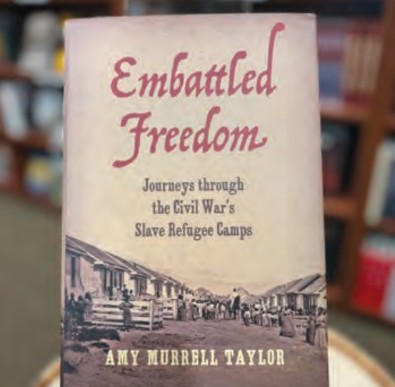NASHVILLE, TN — The annual Path to Freedom Lecture at Fort Negley Park this year will focus on the African Americans who escaped slavery during the Civil War, sought refuge inside Union lines, and managed to survive. Fort Negley represented the first extensive use of newly freed blacks in Tennessee, in the Federal war effort, and its success influenced the later creation of contraband labor camps in other Tennessee towns.
Civil War Historian Amy Murrell Taylor found that these camps multiplied quickly across the wartime landscape, and by 1865 nearly 300 settlements stretched from the coast of Virginia to Kansas, from Missouri down to New Orleans.
Taylor has received multiple national prizes for her book, Embattled Freedom: Journeys Through the Civil War’s Slave Refugee Camps (UNC Press, 2018), including the Civil War and Reconstruction Prize from the Organization of American Historians and the Frederick Douglass Prize given by the Gilder Lehrman Center for the Study of Slavery, Resistance, and Abolition at Yale University. She is the T. Marshall Hahn Jr. Professor of History at the University of Kentucky and president-elect of the Society of Civil War Historians.
Taylor said most of her research about the freedom-seekers in the camps came from depositions and petitions in federal Army records; however, she also found useful the records of the American Missionary Association, as well as journals and newspapers that emerged during the war to report on daily life in the camps and appeal for Northern assistance. Such journals and newspapers included titles such as the Freedman’s Bulletin, The Freedman’s Friend, and the National Freedman.
“It was not uncommon to hear observers refer to the movement of these former slaves as a ‘stampede,’ a ‘flood,’ or a ‘rising tide,’” Taylor writes in Embattled Freedom. “Newspaper articles, government reports, and even captions to illustrations of the wartime flight told of ‘swarms’ that appeared at army camps, and of freedom seekers who ‘circulated much like water’ and ‘rolled like eddies around military posts.’” She quotes W.E.B. Du Bois, writing in the early 20th century (Black Reconstruction), saying this wartime movement was a “great unbroken swell of the ocean.”

Amy Murrell Taylor
Nearly 500,000 refugees walked away from the farms and plantations of their enslavement, in search of refuge behind the lines of the Union army throughout the Civil War, said Taylor. “They worked, worshipped, ate, slept, and endured disease, hunger, and assault inside the camps. They met soldiers from far Northern states, some of them helpful, some of them not; they encountered missionaries eager to teach them. They searched for and found family long separated or sometimes created new kinship ties.”
As the camps multiplied, so too did an entirely new federal bureaucracy established to oversee and protect the residents within them. Never before had federal government agents intervened so directly to protect the interests of those in bondage – it marked, in fact, a reversal of the approach taken by other federal officials who had enforced the 1850 Fugitive Slave Act, laying the groundwork, in effect, for the more well-known Freedmen’s Bureau that emerged by the war’s end.
The story of this monumental exodus from slavery remains relatively unknown among Civil War enthusiasts and historians. Embattled Freedom began as an act of recovery, with a goal of reconstructing, from the military records, newspapers, and missionary reports, the way refugee camps looked and were experienced by those who lived there.
Fort Negley’s annual Path to Freedom Lecture is presented by Metro Parks and Friends of Fort Negley Park. The lecture takes place at the Fort Negley Visitors Center, 1100 Fort Negley Blvd., Nashville, TN 37203. Space is limited and attendees are encouraged to secure their tickets early. Tickets can be purchased by visiting the Fort Negley Eventbrite page.


